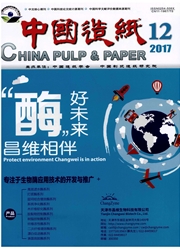

 中文摘要:
中文摘要:
选取一种脂肪酶、两种酯酶处理废纸浆料,并在酶处理后进行浮选脱墨,考察酶处理后废纸浆中胶黏物的去除效果;测定了酶处理前后废纸浆的四氢呋喃抽出物的结构和相对分子质量变化。结果表明,脂肪酶a和酯酶b、c在最佳用量时,脂肪酶a和酯酶C对废纸浆中胶黏物的去除率分别达到46%和59%;一段浮选后,残余油墨浓度分别降低了310mr/kg、411mg/kg和385mg/kg,纸浆白度分别增加了6.9、7.4和7.3个百分点。与脂肪酶相比,酯酶对废纸浆中胶黏物的降解及后续浮选脱墨具有明显优势。凝胶渗透色谱和红外光谱分析表明,经脂肪酶或酯酶处理后,四氢呋喃抽出物的相对分子质量均有明显下降,酯键发生了断裂。此外,酶处理不会对浆料的物理性能产生不利影响。
 英文摘要:
英文摘要:
The recycled pulp was treated with one lipase and two kinds of esterases before flotation, the effect of lipase and esterase treatment on the stickies removal was investigated. Also the changes in structure and molecular weight of the tetrahydrofuran (THF) extractives from the pulps before and after enzyme treatment were determined. The results showed that, with the optimum dosage of enzyme a (lipase) and enzyme c (esterase), the stickies in deinked pulp were reduced by 46% and 59%. Mter the flotation process, the amount of residual ink particle in the pulp decreased 310 mg/kg and 385 mg/kg, and the brightness of the pulp increased 6.9% and 7.3% , respectively. The analysis of GPC and FT-IR showed that with treatment of enzymes a large number of ester bonds of THF extractives were degraded and the molecular weight of THF extractives decreased significantly. Besides, the enzyme treatment had no negative effect on the physical properties of the pulp.
 同期刊论文项目
同期刊论文项目
 同项目期刊论文
同项目期刊论文
 Integrated pulping and biorefining of palm residues based on semichemical cooking and fiber fraction
Integrated pulping and biorefining of palm residues based on semichemical cooking and fiber fraction Tuning Solute Partitioning Coefficients in a Biphasic Ionic Liquid/Water System to Facilitate Extrac
Tuning Solute Partitioning Coefficients in a Biphasic Ionic Liquid/Water System to Facilitate Extrac Ionic Liquid-Based Molecular Oxygen Oxidation of Eucalyptus Kraft Lignin to Obtain a Suite of Monome
Ionic Liquid-Based Molecular Oxygen Oxidation of Eucalyptus Kraft Lignin to Obtain a Suite of Monome Enhanced cellulase hydrolysis of eucalyptus waste fibers from pulp mill by tween80-assisted ferric c
Enhanced cellulase hydrolysis of eucalyptus waste fibers from pulp mill by tween80-assisted ferric c Inhibitory effects of biomass degradation products on ethanol fermentation and a strategy to overcom
Inhibitory effects of biomass degradation products on ethanol fermentation and a strategy to overcom Improved Cellulose Yield in the Production of Dissolving Pulp from Bamboo Using Acetic Acid in Prehy
Improved Cellulose Yield in the Production of Dissolving Pulp from Bamboo Using Acetic Acid in Prehy Graft Polymerization of ε-caprolactone to Cellulose Nanocrystals and Optimization of Grafting Condit
Graft Polymerization of ε-caprolactone to Cellulose Nanocrystals and Optimization of Grafting Condit 期刊信息
期刊信息
